最开始学习树状数组的时候,翻遍了各种帖子,也把刘汝佳的入门经典196也翻了个N遍,可还是不怎么看的明白,无意中发现了这个教程,讲的嘛,反正我个人觉得非常好,当然个人水平比较一般,要不然看了N遍的帖子都不明白,但是感觉人家老外讲的真的非常的清楚,就翻译下吧。
英文水平一般,翻译有误还希望大家批评指正。
原文地址:http://community.topcoder.com/tc?module=Static&d1=tutorials&d2=binaryIndexedTrees
介绍:
我们经常会使用一些数据结构来使我们的算法更加迅速,这篇文章中我们介绍树状数组结构,根据Peter.M.Fenwich,树状数组第一次使用是用来进行数据压缩的,现在,经常用来存储frequencies和计算累计的frequencies表。【译注:这个frequency不知该如何翻译,在中文教程中常用来进行动态连续和查询问题】
首先我们定义下列问题:我们有n个盒子,操作如下:
1. 给第i个盒子增加marble
2. 计算第k...l盒子中的marble和。
最原始的解决方案,对于第一个问题时间复杂度是O(1),,第二个是O(n),假定我们进行m次查询,最坏情况(当只进行第二个问题),时间复杂度是O(n*m),使用类似于RMQ的数据结构,我们可以在最坏O(mlog(n))的情况下求解。另一种方案是使用Binary Indexed Tree 数据结构,他的最坏时间复杂度是O(mlog(n)),但是它更容易编码,而且需要的内存空间更少。
注意:
BIT Binary Indexed Tree(树状数组)
MaxVal maximum value which will have non-zero frequency(frequency非零中的最大值)
f[i] - frequency of value with index i, i = 1 .. MaxVal (数据frequency【其实这里就是我们题目中所说的原始数据】)
c[i] - cumulative frequency for index i (f[1] + f[2] + ... + f[i]) (数据frequency 1...i之和)
tree[i] - sum of frequencies stored in BIT with index i (latter will be described what index means); sometimes we will write tree frequency instead sum of frequencies stored in BIT(存储在BIT中的数据,稍后会为大家讲解)
num¯ - complement of integer num (integer where each binary digit is inverted: 0 -> 1; 1 -> 0 )【num的补充,翻译的不准确,不知如何翻译,但是从下文中可以自行揣测】
NOTE: Often we put f[0] = 0, c[0] = 0, tree[0] = 0, so sometimes I will just ignore index 0.
基本思想:
每个整数都可以表示为sum of powers of two(不知该如何翻译,根据上下文理解吧)。类似的,连续的频率可以表示为多个子频率之和,在我们的例子中,每个集合总包含是非重叠的frequencies.
idx是BIT的下标,r是idx表示为2进制中最后一位1的位置(从左到右),tree[idex]是下标从(idx-2^r+1 ~~ idx)的frequency值之和。从表1.1中可以看出。我们可以将idx表示为(idx-2^r+1 ~~ idx)。(注意核心在于我们的算法中操纵tree的方式)
Image 1.3 - tree of responsibility for indexes (bar shows range of frequencies accumulated in top element)
Image 1.4 - tree with tree frequencies
假定我们查询计算index=13的frequency,13的二进制表示为1101,即,我们计算c[1001]=tree[1101]+tree[1100]+tree[1000]。
隔离最后一位数字
注意:我们用“the last digit”来代替“the last non-zero digit”。
【这部分就不翻译了,感觉作者说的有点复杂了,就是求一个数二进制最后一个1所表示的数的大小,对与13来说,1101,最后一个1在第四位上,即2^0=1,用C++语言描述就是13&(-13),对于任何一个正整数来说,求法都是(num&(-num))】。作者这段的意思就是这样,想看原文了可以回头看看。
读取累计频率
如果我们想读取idx所表示的frequency之和,我们累计tree[idx]之和,每次将idx自身最后一个1移去,重复此过程,知道idx变为0,我们可使用下面这个函数:
int read(int idx){
int sum = 0;
while (idx > 0){
sum += tree[idx];
idx -= (idx & -idx);
}
return sum;
}一个例子,idx=13;sum=0;
Image 1.5 - arrows show path from index to zero which we use to get sum (image shows example for index 13)
所以我们的结果是26,对于idx参数来说,迭代的次数是log MaxVal.
时间复杂度是: O(log MaxVal)
代码长度不超过10行
改变某些位置的frequency并且更新tree
更新tree的概念就是,更新我们所改变frequency值得位置上所影响到的所有tree[idx],读取某个index的frequency,我们移除last bit(即就是最后一个1)并且继续,在tree上修改某个值,我们应该增加当前index的值,增加last digit to index(增加最后一位1),直到index<=MaxVal,c++代码如下:
void update(int idx ,int val){
while (idx <= MaxVal){
tree[idx] += val;
idx += (idx & -idx);
}
}
我们来看看idx=5 这个例子:
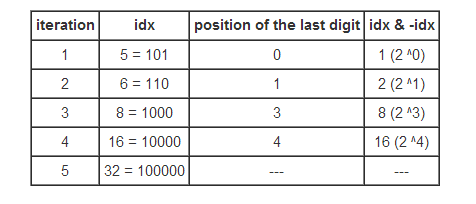
Image 1.6 - Updating tree (in brackets are tree frequencies before updating); arrows show path while we update tree from index to MaxVal (image shows example for index 5)
使用上边的算法,或者根据图1.6的箭头,我们可以更新BIT:
时间复杂度:O(log(MaxVal))
代码长度:不超过10行
读取真实index的frequence,【译注:就是根据tree[index]求出f[index]】
我们已经描述了我们怎样读取index下的连续frequency之和,很明显我们不能仅仅根据tree[idx]来得到真实的f[idx]。一个方法是增加一个额外的数组,分别存储frequency值。这样,读取和存储花费O(1),内存消耗为线性。有时候特别需要节约内存,所以我将展示怎样得到真实的frequency值,而不需要额外的空间。
可能每个读者都已经看到了要获得真实的idx下的值,需要调用read函数两次:f[idx]=read(idx)-read(idx-1),仅仅需要计算两个临近的连续序列。这个过程需要花费2*O(log n)时间,如果我们写一个新的函数,我们可以得到一个更快的算法,并且是较小的常量【最后一句不甚理解】
如果从两个index到root根的两个路径有相同的部分,(即路径有重叠),那么我们可以计算到在路径重合之前的和(sum),减去这个sum值,我们就得到了2个index之间的序列之和。那么邻近index之间的sum和计算或者读取给定index的frequency值则是很简单的 。
【这段话翻译的不好,大家对着原文看看】
Mark given index with x, its predecessor with y. We can represent (binary notation) y as a0b, where b consists of all ones. Then, x will be a1b¯ (note that b¯ consists all zeros). Using our algorithm for getting sum of some index, let it be x, in first iteration we remove the last digit, so after the first iteration x will be a0b¯, mark a new value with z.
对于给定的index=x,前导为y,我们可以将y表示为二进制形式a0b,其中b包含所有的1。让后将x变为 a1b¯ ,(注意 b¯包含所有0 )。使用我们的算法各道一些index的sum值,假设是index是x,第一步我们移除掉最右边的1,那么x就变为了 a0b¯,得到一个新值z。
重复这个过程,使用这个算法,我们将会不断的将index的最后边的1移除,经过几个步骤之后,index的前导y将会变为 a0b¯,刚好等于z。现在,我们写下我们的算法,注意唯一的例外是x等于0.C++代码如下:
int readSingle(int idx){
int sum = tree[idx]; // sum will be decreased
if (idx > 0){ // special case
int z = idx - (idx & -idx); // make z first
idx--; // idx is no important any more, so instead y, you can use idx
while (idx != z){ // at some iteration idx (y) will become z
sum -= tree[idx];
// substruct tree frequency which is between y and "the same path"
idx -= (idx & -idx);
}
}
return sum;
}这里给出一个得到index等于12的真实frequency的过程:
首先,我们计算出z=12-(12&-12)=8,sum=11
Image 1.7 - read actual frequency at some index in BIT (image shows example for index 12)
让我们对比一下,对于给定的index,调用两次read函数和调用我们上边定义的函数。注意对于每个偶数数字,这个算法的时间复杂度为O(1),不会进行迭代,对于绝大多数技术数字的idx,将会花费掉c*O(log(idx))时间,c严格小于1,对比read(idx)-read(idx-1),这个的时间复杂度c1*O(log idx),其中c1则always大于1.
时间复杂度为c*O(log(idx)) c严格小于1
代码长度:不超过15行
Scaling the entire tree by a constant factor【通过一个常数因子将树按比例变化】
有时候我们需要一些factor来scale我们的树,上边描述的过程都非常简单,如果我们想通过一些因子scale,那么对于每一个idx,应该通过-(c-1)*readSingle(idx)/c(因为f[idx]-(c-1)*f[idx]/c=f[idx]/c)函数描写如下:
void scale(int c){
for (int i = 1 ; i <= MaxVal ; i++)
update(-(c - 1) * readSingle(i) / c , i);
}
void scale(int c){
for (int i = 1 ; i <= MaxVal ; i++)
tree[i] = tree[i] / c;
}时间复杂度:O(MaxVal).
代码长度:仅仅几行
对于给定的某一累积frequency,找到相应的index
对于求出给定某一累积frequency,找到相应的index这个问题,最原始最简单的办法就是遍历所有的index,计算累积frequency,然后检测是否与给定的值相等【说白了就是暴搜】。然而,如果我们仅有非负的frequency(意味着index值越大,累积的frequency越大),我们可以找出对数算法,即所谓的二分搜索。我们遍历所有位(从最高位开始),比较当前index累积的frequency与给定值,根据比较结果,(类似于二分搜索),取较低或者较高的一半。c++ 代码如下:
// if in tree exists more than one index with a same
// cumulative frequency, this procedure will return
// some of them (we do not know which one)
// bitMask - initialy, it is the greatest bit of MaxVal
// bitMask store interval which should be searched
int find(int cumFre){
int idx = 0; // this var is result of function
while ((bitMask != 0) && (idx < MaxVal)){ // nobody likes overflow :)
int tIdx = idx + bitMask; // we make midpoint of interval
if (cumFre == tree[tIdx]) // if it is equal, we just return idx
return tIdx;
else if (cumFre > tree[tIdx]){
// if tree frequency "can fit" into cumFre,
// then include it
idx = tIdx; // update index
cumFre -= tree[tIdx]; // set frequency for next loop
}
bitMask >>= 1; // half current interval
}
if (cumFre != 0) // maybe given cumulative frequency doesn't exist
return -1;
else
return idx;
}
// if in tree exists more than one index with a same
// cumulative frequency, this procedure will return
// the greatest one
int findG(int cumFre){
int idx = 0;
while ((bitMask != 0) && (idx < MaxVal)){
int tIdx = idx + bitMask;
if (cumFre >= tree[tIdx]){
// if current cumulative frequency is equal to cumFre,
// we are still looking for higher index (if exists)
idx = tIdx;
cumFre -= tree[tIdx];
}
bitMask >>= 1;
}
if (cumFre != 0)
return -1;
else
return idx;
}例子:给定累积频率为21,函数find工作如下:

代码长度:不超过20行
二维BIT
BIT可以被用做多维数据结构。假定你有屏幕上一个点(坐标非负),你现在有3个问题:
1. 将点设置到(x,y)
2 将点从(x,y)移除掉
3 计算矩形((0,0),(x,y))中点的数量。
如果进行m次询问,max_x是x的最大值,max_y是y的最大值,这样问题可以在O(m * log (max_x) * log (max_y)).时间内解决。在这种情况下,tree的每个元素将包含数组(tree[max_x][max_y])。更新x坐标的索引与上边的类似,例如,假定我们设定/移除点(a,b),我们定义更新函数update(a,b,1)/update(a,b,-1)。update函数如下:
void update(int x , int y , int val){
while (x <= max_x){
updatey(x , y , val);
// this function should update array tree[x]
x += (x & -x);
}
}updatey与update类似:
void updatey(int x , int y , int val){
while (y <= max_y){
tree[x][y] += val;
y += (y & -y);
}
}也可写在一个函数中:
void update(int x , int y , int val){
int y1;
while (x <= max_x){
y1 = y;
while (y1 <= max_y){
tree[x][y1] += val;
y1 += (y1 & -y1);
}
x += (x & -x);
}
}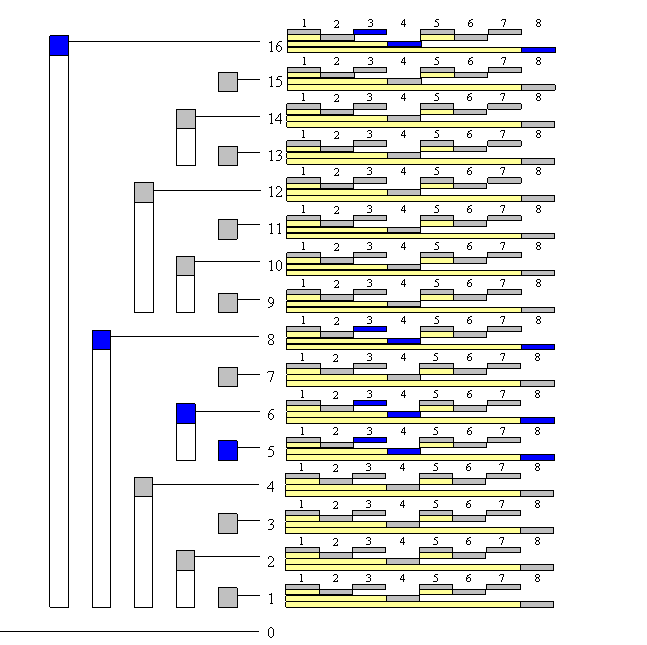
Blue fields are fields which we should update when we are updating index (5 , 3).
#include <cstdio>
#include <stdlib.h>
#include <algorithm>
#include <string.h>
using namespace std;
int num[5005] , total[5005];
int n;
int lowbit( int x )
{
return x&(-x);
}
int query( int x )
{
int ret = 0;
x += 1;
while( x <= n )
{
ret += total[x];
x += lowbit(x);
}
return ret ;
}
void update( int x )
{
while( x > 0 )
{
total[x]++;
x -= lowbit(x);
}
}
int main( )
{
while( scanf("%d",&n) != EOF )
{
memset( total , 0 , sizeof(total) );
memset( num , 0 , sizeof(num) );
int sum = 0;
for( int i=0 ; i<n ; i++ ){
scanf("%d",&num[i]);
update( num[i]+1 );
sum += query( num[i]+1 );
//printf("%d\n",sum);
}
int k;
int s = sum;
for( int i=0 ; i<n ; i++ ){
k = sum + n-1 - 2*num[i];
sum = k;
if( k < s )
s = k;
}
printf("%d\n",s);
}
return 0;
}








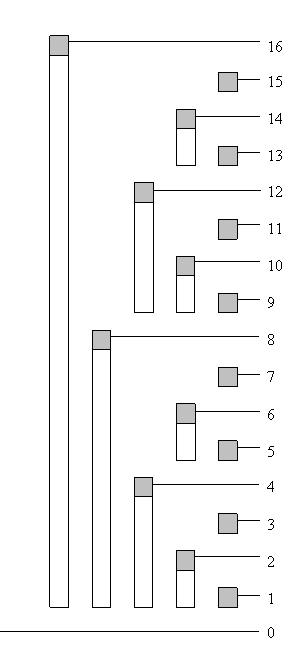
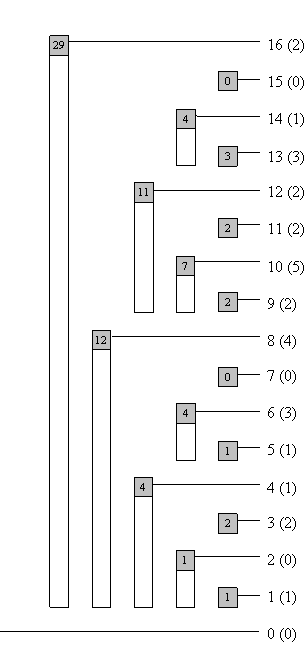
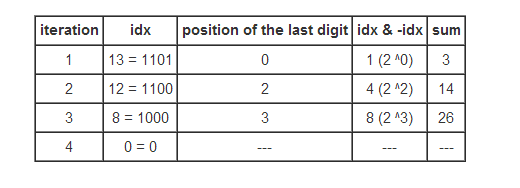
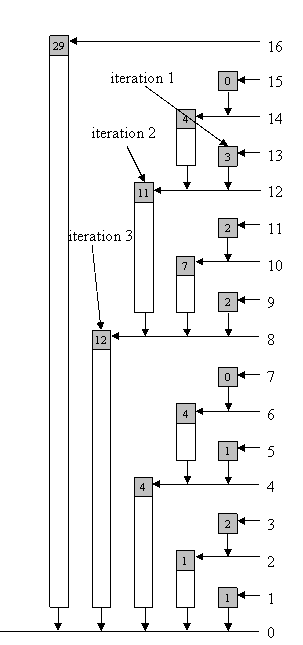
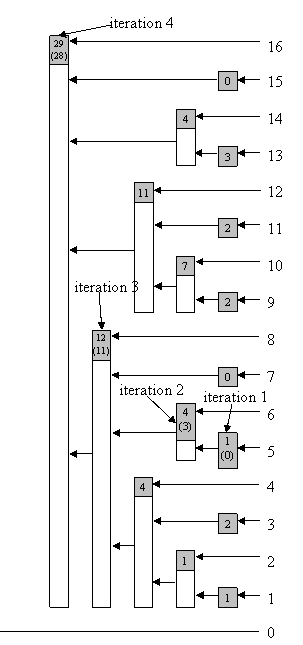
















 693
693











 被折叠的 条评论
为什么被折叠?
被折叠的 条评论
为什么被折叠?








